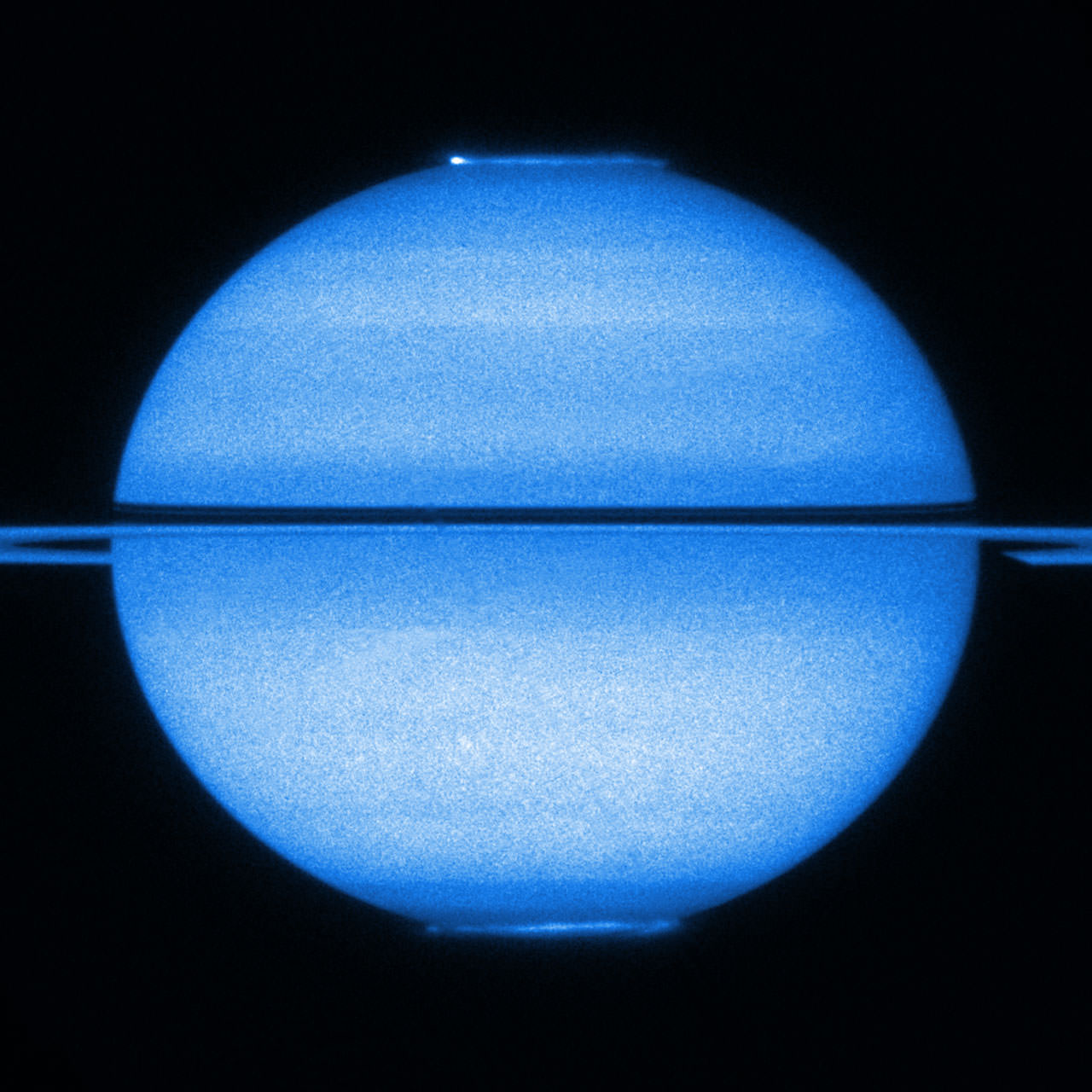In January and March 2009, researchers using Hubble took advantage of a rare opportunity to record Saturn when its rings are edge-on, resulting in a unique look featuring both of the giant planet’s poles. And Saturn cooperated by providing an incredible double light show with Saturn’s own northern and southern lights. Since Saturn is only in this position every 15 years or so, this favorable orientation has allowed a sustained study of the two beautiful and dynamic aurorae.
Since it takes Saturn almost thirty years to orbit the Sun, the opportunity to image both of its poles occurs only twice in that period. Hubble has been snapping pictures of the planet at different angles since the beginning of the mission in 1990, but 2009 brought a unique chance for Hubble to image Saturn with the rings edge-on and both poles in view. At the same time Saturn was approaching its equinox so both poles were equally illuminated by the Sun’s rays.
[/caption]
These recent observations go well beyond just a still image and have allowed researchers to monitor the behavior of both Saturn’s poles in the same shot over a sustained period of time. The movie they created from the data, collected over several days during January and March 2009, has aided astronomers studying both Saturn’s northern and southern aurorae. Given the rarity of such an event, this new footage will likely be the last and best equinox movie that Hubble captures of our planetary neighbor.
Despite its remoteness, the Sun’s influence is still felt by Saturn. The Sun constantly emits particles that reach all the planets of the Solar System as the solar wind. When this electrically charged stream gets close to a planet with a magnetic field, like Saturn or the Earth, the field traps the particles, bouncing them back and forth between its two poles. A natural consequence of the shape of the planet’s magnetic field, a series of invisible “traffic lanes” exist between the two poles along which the electrically charged particles are confined as they oscillate between the poles. The magnetic field is stronger at the poles and the particles tend to concentrate there, where they interact with atoms in the upper layers of the atmosphere, creating aurorae, the familiar glow that the inhabitants of the Earth’s polar regions know as the northern and southern lights.
At first glance the light show of Saturn’s aurorae appears symmetric at the two poles. However, analysing the new data in greater detail, astronomers have discovered some subtle differences between the northern and southern aurorae, which reveal important information about Saturn’s magnetic field. The northern auroral oval is slightly smaller and more intense than the southern one, implying that Saturn’s magnetic field is not equally distributed across the planet; it is slightly uneven and stronger in the north than the south. As a result, the electrically charged particles in the north are accelerated to higher energies as they are fired toward the atmosphere than those in the south. This confirms a previous result obtained by the space probe Cassini, in orbit around the ringed planet since 2004.
Source: ESA


My eyes maybe seeing something that really isn’t there (or my brain is?), but what is that faint line that seems to run from the upper left hemisphere towards the lower right hemisphere? Image artifact?
Why does NASA release some discoveries they day they find them, and others months/years later?
@munisano – An interesting observation… secondary mirror diffraction? filter wheel artifacts? They seem to be @ 90 deg. in most frames but not all? Can we get a clarification on that Nancy?
@munisano:
Those are artifacts (even faintly visible in the still above). Other linear artifacts are visible in the video, others appear to be shadows cast by Saturn’s moons.
I’m wondering if any of the auroral emissions are tied to “flux tubes” between Saturn and any of its moons, similar to what is seen wrt Jupiter-Io?
@SuperKevin — Imaging from hubble is typically the property of the principal investigator at the time of the discovery. That entity, whoever/whatever they are, may choose to keep the data for a short time before releasing the images to the public after a period of 1 year (this can be extended if approved by a director of some kind).
Observers can also apply for discretionary time, images collected during these sessions are released immediately.